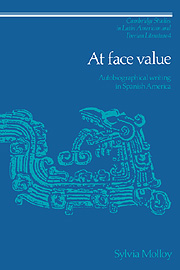Book contents
- Frontmatter
- Contents
- Acknowledgments
- Introduction
- PART I THE SCENE OF READING
- PART II CHILDHOOD AND FAMILY TALES
- PART III MEMORY, LINEAGE AND REPRESENTATION
- 8 Autobiography as history: a statue for posterity
- 9 Shrines and labyrinths: a place to remember
- 10 First memories, first myths: Vasconcelos' Ulises criollo
- Notes
- Bibliography
- Index
9 - Shrines and labyrinths: a place to remember
Published online by Cambridge University Press: 14 September 2009
- Frontmatter
- Contents
- Acknowledgments
- Introduction
- PART I THE SCENE OF READING
- PART II CHILDHOOD AND FAMILY TALES
- PART III MEMORY, LINEAGE AND REPRESENTATION
- 8 Autobiography as history: a statue for posterity
- 9 Shrines and labyrinths: a place to remember
- 10 First memories, first myths: Vasconcelos' Ulises criollo
- Notes
- Bibliography
- Index
Summary
… A kind of temporal abandonment, where camphor or poppy seeds, in a silent and nocturnal vegetal growth, prepare an oval and crystalline identity, and where the isolation of a group provokes a communication that is like a universal mirror.
José Lezama Lima, ParadisoThat Sarmiento's memory, as an individual, should take on the form of a reflection on genealogy – the gathering of family precursors with whom Sarmiento identifies – is not coincidental. From the Inca Garcilaso, who as a child eagerly heard his mother and her brothers evoke a shared Inca past on the verge of oblivion, to Borges who, in his inscription to his Obras completas, thanks his mother for “your memory and, within it, the memory of our elders,” the past, in Spanish America, appears to be, very consciously, a family affair. Borges himself, faced in Evaristo Carriego with the biographer's (and perhaps the autobiographer's) dilemma – “that one person should wish to awaken in another memories that only belonged to a third person is an obvious paradox” – resorts to an ingenious explanation of the workings of memory in Spanish America:
[O]nly new countries have a past; that is, an autobiographical sense of that past, a living history. If time is succession, then we must admit that wherever there is a greater density of events, more time flows, and that it flows abundantly in this inconsequent part of the world. The conquest and colonization of these domains … was so inconsistent that, in 1872, one of my grandfathers was to command the last major battle against the Indians, bringing to a close, in the late nineteenth century, the conquest of the sixteenth century. […]
- Type
- Chapter
- Information
- At Face ValueAutobiographical Writing in Spanish America, pp. 159 - 185Publisher: Cambridge University PressPrint publication year: 1991

